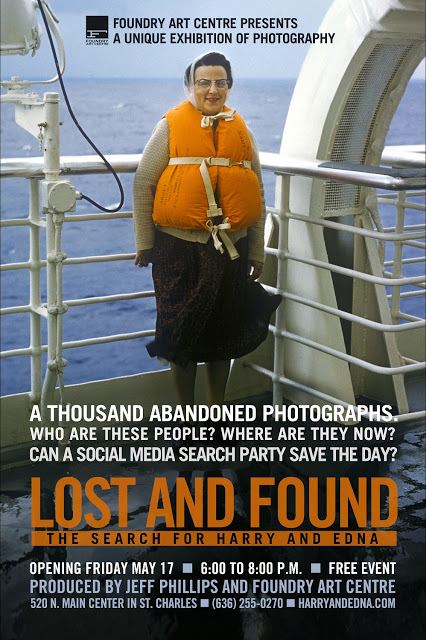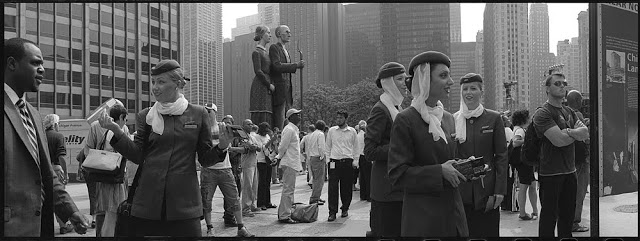Jeff Phillips: Lost and Found
Harry and Edna. How perfect… right?


Is This your Mother? showed me how non-photographers consume photographs. When a photograph is anonymous—and stripped of its original context—the viewers seemed to be more carefree with his or her own interpretation of an image. Before Harry and Edna’s identities were discovered, people who visited the page crafted clever fictional captions for each photograph I posted. Some claimed that they were certain that Harry or Edna were a distant relative. Other comments strayed toward the dark side, failing to adequately veil the fears or insecurities of their authors.


Someone wrote to me and said, “We create photographs so differently today than they did fifty years ago.” Is this really true?
Harry’s photographs remind us of the evolution of our photographic tools in the last 50 years, but not in the direction that you may suspect. Harry used a completely manual camera, and his images were tack sharp and perfectly exposed. Each roll of film gave Harry 36 chances to make a photograph, and in most of the slide trays, no less than 34 out of the 36 were technically perfect. Looking at the slides in their trays, I began to wonder if the way we share photographs today is different than it was fifty years ago.
 In Harry and Edna’s day, photographic slides were shared with others by gathering together in a living room or basement and projecting the images on a screen (or a white sheet, pinned to the wall.) Any person who has ever been held captive to an old school slide show of vacation photos will tell you that the demise of slide projectors isn’t history’s greatest tragedy. Is today’s constant barrage of I CAN HAS cat pictures and Instagram dinner plate photographs any less painful?
In Harry and Edna’s day, photographic slides were shared with others by gathering together in a living room or basement and projecting the images on a screen (or a white sheet, pinned to the wall.) Any person who has ever been held captive to an old school slide show of vacation photos will tell you that the demise of slide projectors isn’t history’s greatest tragedy. Is today’s constant barrage of I CAN HAS cat pictures and Instagram dinner plate photographs any less painful?  Why did the family discard these family photographs? Is the way we preserve our photographs today any different than it was fifty years ago?
Why did the family discard these family photographs? Is the way we preserve our photographs today any different than it was fifty years ago?
The images of Harry and Edna were discarded because they could no longer be easily decoded – in other words, their “format” was obsolete. Without a projector, the family couldn’t see or share the photographs. Our photographs today are not any safer from obsolescence, especially when a memory card fails or a hard disk crashes—or when we upgrade to the newest mobile device. How will we preserve images for our grandchildren? As the next fifty years passes, will our photographs be within easy reach, online or offline?  Is This Your Mother? is now a physical exhibition entitled, Lost and Found. The most common question asked of me about the Lost and Found exhibition is, “When first contact was made with Harry and Edna’s relatives, did they demand the return of the slides?”
Is This Your Mother? is now a physical exhibition entitled, Lost and Found. The most common question asked of me about the Lost and Found exhibition is, “When first contact was made with Harry and Edna’s relatives, did they demand the return of the slides?”

The truth is that the family have been tremendously supportive. Marcia, a great niece, wrote in the family’s very first email to me:
Dear Jeff,
I am one of Harry & Edna’s Great Nieces. I received an e-mail … regarding the FB page. You have gone to great lengths to find our family and it is heartwarming and a little creepy (in a fun way) to see how interested others are in my Great Aunt and Uncle.
–Marcia
I sensed that the family just wanted to see them. Almost immediately, they became active participants in the reactivation of Harry and Edna’s memory. They were modern consumers of their own family photographs, curated by a stranger and delivered through Facebook, the very place where Harry and Edna were rediscovered.

In the Lost and Found exhibition, the gallery wall has become the Facebook wall – the show integrates the original visitor comments with large format prints made from the Kodachrome slides. The Facebook crew who discovered the identity of Harry and Edna also helped curate the show – again, through a voting process on Facebook. The show’s current location in St. Louis, where the gallery has placed billboard ads around the city featuring a 20 foot tall Edna, in her orange life vest. When I asked a family member to guess how Harry and Edna would react to all of this attention, she replied, “Harry would be cracking up. Edna would be mortified.” –Jeff Phillips
Posts on Lenscratch may not be reproduced without the permission of the Lenscratch staff and the photographer.
Recommended
-
Salua Ares: Absense as FormNovember 29th, 2025
-
Ricardo Miguel Hernández: When the memory turns to dust and Beyond PainNovember 28th, 2025
-
Pamela Landau Connolly: Columbus DriveNovember 26th, 2025
-
KELIY ANDERSON-STALEY: Wilderness No longer at the Edge of ThingsNovember 19th, 2025
-
Jackie Mulder: Thought TrailsNovember 18th, 2025






































































